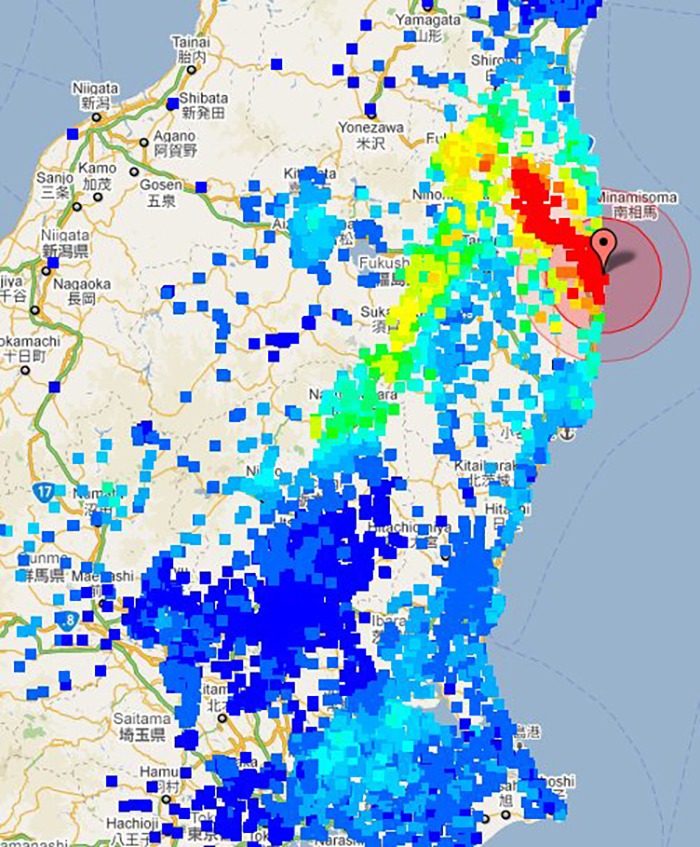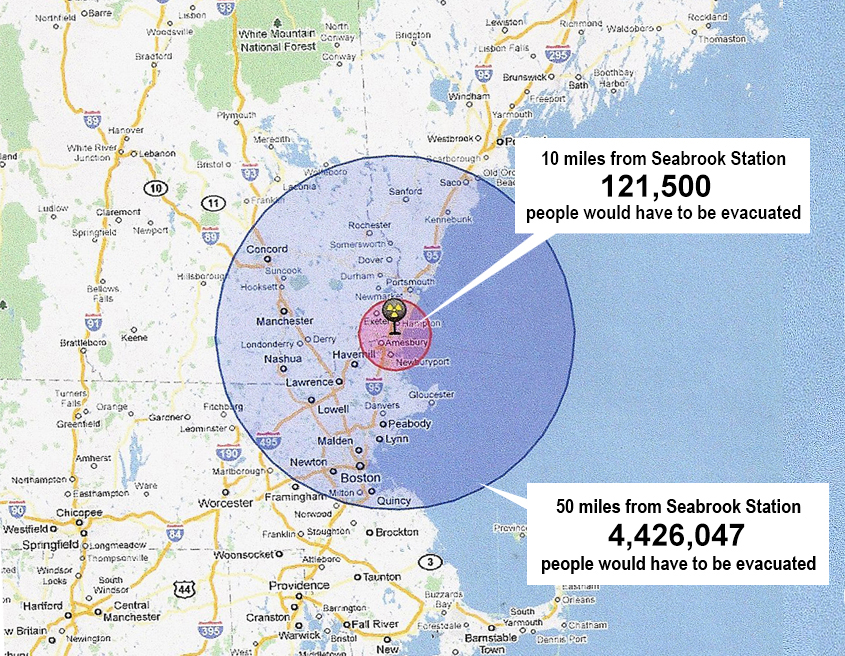After the incident at Fukushima, our Nuclear Regulatory Commission advised the American Embassy to have Americans evacuate at a 50-mile radius from the Fukushima Daiichi plant. Meanwhile, here at Seabrook, our evacuation planning zone still remains at a mere 10 miles from the reactor.
THE REALITY OF EVACUATION
Consider the case of Fukushima Daiichi. Authorities quickly realized that their original 20-kilometer (12-mile) evacuation zone was inadequate and the exclusion zone expanded as radiation leaked from the plant. Unsafe radiation was measured in Tokyo far to the south (160 miles away), even though the prevailing wind was to the northwest or offshore. Communities 30 miles from the plant remain uninhabitable to this day.
We need effective and realistic emergency planning for Seabrook Station. This includes reevaluating our emergency plan and increasing the emergency planning radius to 50 miles to account for an actual evacuation.
This map shows population estimates for a 10- and 50-mile radius around Seabrook. While the current 10-mile Emergency Planning Zone would necessitate the evacuation of an estimated 121,500 people, a more realistic scenario would require the evacuation of more than 4.4 MILLION people. Something we are wholly unprepared for. These numbers also don't account for the population swell of summer, commuters, and places of business.
To get an idea of the scope of a full 50-mile evacuation, view a full list of towns and cities in our current evacuation zone as compared to a full 50-mile evacuation.
RECEIVING TOWNS ARE NOT IN THE CLEAR
The current DOS Reception Centers assigned to take evacuees are all well within a 50 mile radius of the Seabrook reactor. The Dover Middle School (which will be accepting every resident from Greenland, Hampton, Hampton Falls, New Castle, North Hampton, and Rye) is only 20 miles from the nuclear power plant, and often directly downwind as well.
Do we realistically believe this is a sound plan, when the residents of Dover will likely need to evacuate themselves – and with no plan in place? How will families locate each other in this scenario? These are not alarmist questions; they are questions we need to answer.
Profit Over Safety
As a publicly traded company, NextEra Energy has no impetus to address safety issues at Seabrook. It’s a simple matter of profit margin. But we at SAPL—and we the residents who are affected by the plant—need to address these safety issues.
We are the people who will suffer the consequences of mismanagement and poor planning, and we are the ones who will pay the cost in the event of an emergency, so we must also make sure that we have the best possible emergency plan in place.
- Emergency planning zones around Seabrook and all US nuclear plants MUST be expanded to realistic distances for nuclear events. We cannot ask Americans to evacuate 50 miles out in Japan and assume that 10 miles will be sufficient here.
- Regardless of one’s opinions on nuclear power, our collective response to an increasingly possible accident at Seabrook Station is absolutely critical and must be addressed as such. The plan must be expanded and improved.
- Even without the larger evacuation zone, the current evacuation plan does not take into account the logistics of Hampton Beach on a summer day, or the ever growing population of the Seacoast Region. The idea that we can somehow evacuate tens of thousands of people with volunteer-driven school buses is unrealistic.
- When performing cost-benefit analyses, we need to account for the true cost of a nuclear accident. How do we account for the indefinite displacement of hundreds of thousands of people? How do we account for rendering hundreds of towns and cities uninhabitable for even one year?
LEARN MORE
- Fukushima Five Years On: Lessons and Concerns for Seabrook’s Future
Nuclear engineer Arnie Gundersen shares his insights with SAPL after a fact finding trip to Japan. - Populations around U.S. nuke plants soar
Associated Press. From 2011, but still very current, this is an excellent AP article on population growth around nuclear plants and the serious evacuation zone problems that are arising. - VIDEO: Why A 10-mile Evacuation Zone is Arbitrary and Unsafe
Fairewinds’ Chief Engineer Arnie Gundersen emphasizes the need to enlarge evacuation zones around US nuclear plants to 50 miles.


